Coverage on this live blog has ended. Please click here for the latest updates.
The frantic search to find the missing Titanic tourist submersible expanded "exponentially" Wednesday as crews canvassed a surface area twice the size of Connecticut and 2.5 miles deep.
The search is focused on an area where Canadian aircraft detected “underwater noises” Tuesday and, again, Wednesday.
The sounds prompted redirected searches by remotely operated vehicles, the U.S. Coast Guard said early Wednesday, noting that the effort had so far "yielded negative results."
The five people on board the vessel, which vanished during a mission to explore the wreckage of the Titanic, had less than 40 hours of oxygen supply left Tuesday afternoon, a Coast Guard official said, making the bid to find the vessel a race against time.
Those on the missing vessel, named Titan, have been identified as Stockton Rush, the CEO of OceanGate Expeditions, the company behind the mission; British billionaire Hamish Harding, the owner of Action Aviation; French dive expert Paul Henry Nargeolet; and prominent Pakistani businessman Shahzada Dawood and his son, Suleman.
Coverage on this live blog has ended. Please click here for the latest updates.
What to know about the missing sub
- The submersible, named Titan, disappeared Sunday during a mission to survey the wreckage of the Titanic, which is 900 nautical miles east of Cape Cod, Massachusetts.
- The vessel had up to a 96-hour oxygen supply, and the U.S. Coast Guard said Wednesday it predicts the oxygen supply on the Titan will run out at 7:08 a.m. ET Thursday.
- The price of a spot on the sub, which can carry five people, was $250,000. It was on its third trip since OceanGate Expeditions began offering trips in 2021.
- The rescue operation is not just racing the clock — it also faces an extreme environment.
Explorers Club hopeful remotely operated vehicle can assist in search for missing submersible
A Magellan “working class” remotely operated vehicle is on the way to the search for the Titan, and it could provide equipment with a manipulator arm, the president of New York City’s Explorers Club said Wednesday.
The Magellan remotely operated vehicle, or ROV, is expected to reach the search site within 24 hours, Explorers Club President Richard Garriott told NBC New York in an interview.
“It appears now that it’s most likely that the submersible is sitting on the sea floor, and there’s reason to believe the crew is alive, because there have been sounds that appear to have been heard,” he said.
U.S. Navy experts are analyzing the noises. The U.S. Coast Guard has not given information about the possible origin of the noises. It said early Wednesday that ROV operations were relocated to explore where the sound came from.
A Magellan ROV was among the assets on the way to assist in the search for the sub, the Coast Guard said Wednesday.
A working class ROV has a manipulator arm that can attach to a hull point and potentially lift it off the surface, Garriott said.
Garriott said "there absolutely is hope." He said that those aboard will know how to stretch their available air and that the cold environment will also depress body functions and decrease the air needed.
Two of the five people aboard the submersible — Hamish Harding and Paul Henry Nargeolet — are Explorers Club members.
Titan raises legal questions for high-risk businesses
The decision by five people to undertake a dangerous and most likely ill-fated undersea voyage to visit the wreck of the Titanic is raising questions about the liabilities assumed by people and businesses taking part in risky activities.
Experts say that no set rubric determines whether a business will have to pay damages in the event of a mishap and that most operators buy liability insurance anyway because the waiver forms they ask clients to sign may not ultimately be enforceable.
In the U.S., whether a business operator becomes liable for a catastrophe can depend on the laws of the state where the business operates or even a judge’s interpretation of the waiver form, said Kenneth S. Abraham, a distinguished professor of law at the University of Virginia.
Those aboard missing submersible could be conserving oxygen
The people on the Titan could be limiting their use of oxygen as searchers look for them, potentially extending how long they can wait, an expert theorized.
The Coast Guard has estimated that the submersible could run out of air by 7 a.m. Thursday.
“It may be that they are conserving oxygen,” said Jules Jaffe, a research oceanographer at the University of California, San Diego, who was part of a team involved in finding the Titanic wreckage in 1985. “If they were imagining that they would run out of oxygen, the smart thing to do would be to reduce your metabolic effort and perhaps lay very still.”
“Maybe we’re thinking it’s going to run out of air sooner than possible,” he said in an interview on NBC News Now.
The Coast Guard projects that the oxygen supply on the Titan will run out at 7:08 a.m. ET Thursday, a spokeswoman said. OceanGate’s specs say the submersible is equipped with 96 hours of oxygen.
Search patterns show more sea scanned for Titan
The U.S. Coast Guard and other searchers continued to look for the Titan today, and the Coast Guard released a new image showing search patterns so far.

The Coast Guard also released search patterns Tuesday, and the difference is seen in the above image.
Searchers have covered an area twice the size of Connecticut on the surface, and the search underwater is about 2 ½ miles deep in what Coast Guard Capt. Jamie Frederick has called “an incredibly complex search operation.”
An HC-130 Hercules covered 879 miles this afternoon, the Coast Guard said.
It was one of two HC-130 flights scheduled for today, Frederick said. Two flights by Canadian CP-140 Aurora planes — also called P-3s — were also scheduled for today, he said.
There are also surface ships and remotely operated vehicles, and more are on the way, officials said.
OceanGate business neighbor says he’s in disbelief
A Washington state man whose business is next to OceanGate and who knows the engineers said today he’s in disbelief that the submersible has gone missing but has hope for the five people aboard.
Bryan Dennis, who owns Puget Sound Composite in Everett, said he sees OceanGate and the people on the Titan as regular people “willing to put themselves on the edge of the innovative capacity of the technology.”
“These are the types of situations that you hear about, kind of, in Hollywood movies. It’s not something I would have thought could happen to ordinary people,” he said.
The submersible is the subject of an intense search in the North Atlantic the estimate of its remaining air dwindles.
“We have a lot of hope,” Dennis said. “I think that they are capable and competent and have the right heart for what they’re doing. And so we’ve been praying for them.”
Dennis said he has spoken to OceanGate CEO Stockton Rush in the past on occasion and described him as “a gentleman, scholar” and someone who is patient and a good leader.
Photos of the Titanic wreckage over 100 years later
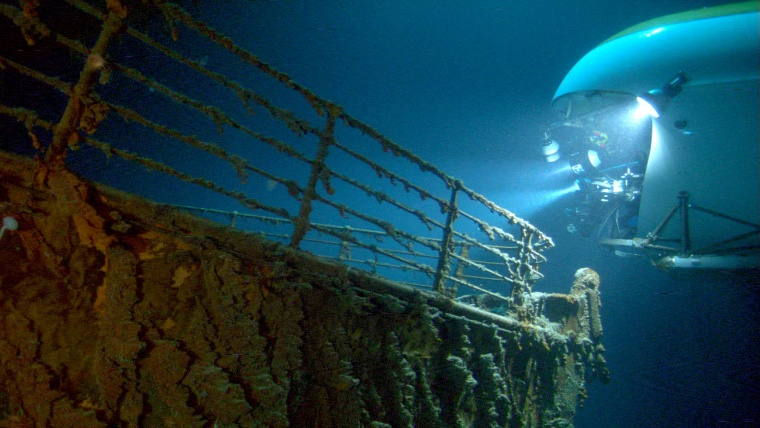
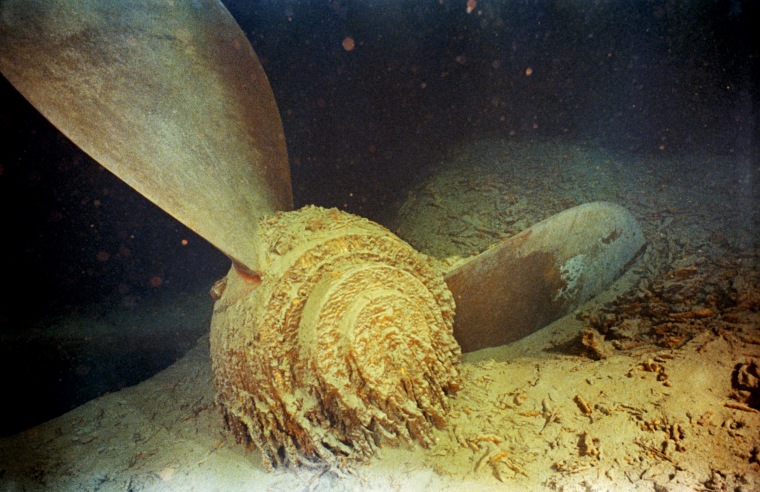
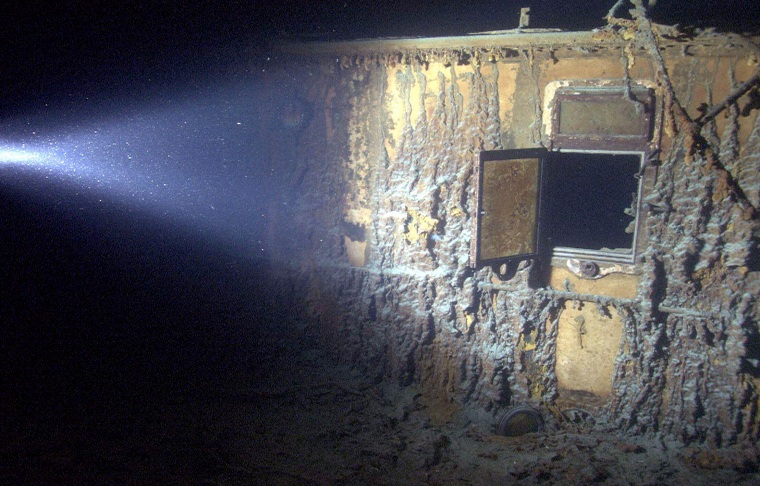
The Titanic's final resting place at the bottom of the ocean was found in 1985, over 70 years after it sank, allowing researchers and scientists to study and capture the wreckage in images and video.
A tale of two disasters: Missing Titanic sub captivates the world days after deadly migrant shipwreck
As rescuers raced to find a handful of wealthy people and explorers who vanished after launching a mission to survey the Titanic, another disaster at sea that’s feared to have left hundreds of people dead has been swept from the spotlight.
Last week’s sinking of a fishing boat crowded with migrants trying to get from Libya to Italy sparked arrests, violent protests and questions about authorities’ failure to act or find a long-term solution to the issue. But many human rights advocates are frustrated that the world seems to have already moved on and that the resources and media attention being dedicated to the Titan rescue efforts far outweigh those for the sunken migrant ship.
“It’s a horrifying and disgusting contrast,” Judith Sunderland, associate director for Human Rights Watch’s Europe and Central Asia division, said in a telephone interview, reflecting on the apparent disparities in resources and media attention on the two crises.
Canadian Armed Forces share video of search for missing sub
The Titanic brought them together, and a tiny vessel could doom them
It was early 2019, and aerospace engineer Stockton Rush was racing against the clock. The wreckage of the Titanic was slowly decaying — ravaged by metal-eating bacteria, researchers found — and Rush felt there was suddenly a “pressing need to document the world’s most famous shipwreck, combined with a huge demand of people who wanted to go see it.”
“It made perfect sense,” Rush, the CEO of OceanGate Expeditions, told the German broadcaster Deutsche Welle. “We just had to make the submersible to get there.”
The carbon-fiber submersible his team built, known as the Titan, differentiated itself from similar vessels in part because it had room for at least four “affluent travelers,” including an expert. “If you’re going to take somebody to go see the Titanic,” he said, “it’s going to be the most life-changing experience for them. They won’t want to do it alone.”
Four years later, Rush and four other men, united by their shared zeal for adventure and the financial resources to chase after it, converged on St. John’s, Newfoundland, for the start of their voyage to survey the remnants of a luxury cruise liner that sank 111 years ago. It was OceanGate’s third trip to the remains of the Titanic, with a fare of $250,000 per traveler.
Submersible could be caught in Titanic wreckage, scientist theorizes
Jeff Karson, a deep sea researcher, pointed to two possible explanations for the missing Titan submersible. In one scenario, a mechanical failure may have prevented the watercraft from dropping the steel weights that help it travel to the ocean floor, he said.
But the likelier explanation, he said, is that the submersible is entangled in or caught underneath a piece of the Titanic wreckage.
The passengers may have “run into some bad luck,” said Karson, a professor emeritus of earth and environmental sciences at Syracuse University who has conducted numerous scientific expeditions to the ocean floor via a submersible named Alvin.
“They could be like a balloon that floats to the top of your ceiling. They just can’t go up any more,” he said.
Based on his experience, Karson said, conditions inside the Titan are likely cold and cramped, with just a single window through which to view the surrounding darkness. Temperatures at the bottom of the ocean are just above freezing and the inside of the submersible is likely dripping wet from condensation, he added.
At about 12,500 feet below sea level, the Titanic remains are in a “very forbidding” environment, Karson said.
“It is completely silent,” he said. “There’s no currents. There’s no weather. It’s just this unbelievable, dark, still place.”
Coast Guard projects oxygen to run out Thursday morning
The U.S. Coast Guard projects that the oxygen supply on the Titan will run out at 7:08 a.m. ET Thursday, a spokeswoman said this afternoon.
OceanGate's specs for the Titan submersible say it is equipped with 96 hours of oxygen. The Coast Guard said around 1 p.m. ET Tuesday that rescuers had 41 hours left.
Rescue mission not likely to bust Coast Guard budget
The increasingly desperate mission to rescue the Titan submersible is not likely to incur extra costs for the Coast Guard and, by extension, U.S. taxpayers, experts said.
"I don’t think there’s going to be exorbitant extra costs here," said Aaron Davenport of the Rand Corp., who served in the Coast Guard and took part in numerous rescue missions. "The ships responding to this situation were already on patrol and saving lives is always the highest priority. The Coast Guard doesn’t do underwater stuff. It patrols the surface. There are other agencies that have the capacity to do that, not to mention private companies."
David Marquet, a retired Navy captain, agreed. "I think the big costs come in terms of what are the commercial entities charging the government for their services here and who is going to pick them up," he said.
Polar Prince owner will 'continue to hold out hope until the very end'
The Polar Prince, which had accompanied the missing Titan submersible, will remain on scene until the potential bitter end as desperate rescuers continue their hunt for the missing craft.
"The equipment that’s been mobilized for this is the finest in the world, the most capable in the world," Horizon Maritime president Sean Leet told reporters on Wednesday. "We have to hold out hope. I think as you're aware, there’s still life support available on the submersible and we’ll continue to hold out hope until the very end."
More ROVs and assets on the way to aid in the search
The search for the Titan, 900 miles off the coast of Cape Cod and 400 miles southeast of St. John's, has proved challenging in mobilizing “large amounts of equipment quickly,” a Coast Guard official said Wednesday.
But help continues to head toward the site.
Five surface assets are currently searching and 10 are expected to be active in the next 24 to 48 hours, First Coast Guard District response coordinator Capt. Jamie Frederick said.
Two ROVs — remotely operated underwater machines — are currently searching in the ocean with more expected to arrive Thursday morning.
There have been two back-to-back P-3 flights totaling 14 hours of continuous coverage surveying the seas, as well as two C-130 flights.
P-3 aircraft heard 'noises' yesterday and today, but determining the source is complicated
"Noises" were detected by P-3 aircraft scouring the search site of the missing OceanGate submersible on Tuesday and again on Wednesday, officials said in a news briefing Wednesday.
A Navy analysis of noises from last night came back inconclusive, First Coast Guard District Capt. Jamie Frederick said. ROVs were relocated to find the origin of the noises and more are expected to arrive Thursday morning,
“We don’t know what [the noises] are to be frank with you," Frederick said. "The intent will be to continue to search in those areas where the noises were detected ... then put additional ROVs down in the last known position where the original search was taking place.”
Carl Hartsfield, with the Woods Hole Oceanographic Institution, warned it's "very difficult" to discern the source of noises in the vast ocean.
He said some of the noises "have been described as banging noises" but experts have to consider the context and eliminate the possibility that it could be made from human-made sources other than the Titan.
“Everyone of those noises is being analyzed, tracked, looked for patterns and reported upon,” Hartsfield said.
This is a 'search and rescue mission,' Coast Guard says
Capt. Jamie Frederick, the First Coast Guard District response coordinator, described the desperate search for the Titan as a "search and rescue mission, 100%" on Wednesday.
"We are smack dab in the middle of search and rescue," he said. "And we'll continue to put every available asset that we have in an effort to find the Titan and the crew members."
Frederick noted that the five passengers on board the Titan have a "limited ration" of food and water, but it's not clear how much.
Surface search expanded to double the size of Connecticut, Coast Guard says
The search for the missing submersible Titan has expanded to twice the size of the state of Connecticut, Capt. Jamie Frederick, the First Coast Guard District response coordinator, said Wednesday.
The sub surface search is up to 2.5 miles deep, he added.
He said the search is "exponentially" expanding, noting its complexity given its distance so far off shore.
Pakistani businessman's close friend describes enthusiastic traveler with love of Titanic lore
Shahzada Dawood, the wealthy Pakistani businessman who is aboard the OceanGate vessel with his 19-year-old son, enjoys taking ambitious trips to exotic locales around the world and learning about the Titanic at museum exhibitions, according to a man who has known him since they were kids.
Muhammad Hashim, 48, a businessman who lives in Lahore, said in a phone interview Wednesday afternoon that he met Dawood when they were in high school. Dawood tends to be reserved and introverted, Hashim said, but the two men kept in close touch over the years.
They last spoke on Thursday, the day before Dawood and his son, Suleman, started their voyage. The elder Dawood called Hashim from Ontario, where he was preparing to board a flight to St. John's, Newfoundland. Hashim was not aware that Suleman was with him.
"He wasn't nervous at all," Hashim said, explaining that Shahzada is a devoted traveler who has visited places like Antarctica and Kalahari Desert, an arid savanna in Southern Africa.
Hashim is trying to remain hopeful, but he knows the odds are increasingly stacked against the Dawoods: "I hope there's a happy outcome, but I have no idea what to say at the moment. We are keeping our fingers crossed, and that's it."
French ship will arrive to search site this afternoon
The French ship the Atalante is expected to arrive at the search area for Titan at 4:30 p.m. ET Wednesday, the French maritime ministry said.
On board is a “Victor6000” exploration robot that can dive to a depth of 4,000 meters or roughly 13,100 feet.
The remains of the Titanic, which sank more than a century ago, settled at a depth of around 12,500 feet.
Three vessels arrived to search site this morning
Three vessels arrived to the search area for the missing OceanGate submersible Wednesday morning, the Coast Guard said.
The John Cabot, which has side scanning sonar capabilities, is working alongside the Skandi Vinland and the Atlantic Merlin.
Wednesday’s sea conditions include 6- to 7-foot swells and 23 mph winds in 50 degree Fahrenheit weather.
The Coast Guard will hold a press briefing at 1 p.m. E.T. on the search efforts.
Explorers Club lobbies Congress to approve deep-sea rover
The Explorers Club, a society dedicated to scientific exploration and field study, is asking its members to lobby Congress to approve the use a deep-sea rover in the search for Titan.
Two passengers on Titan — Hamish Harding and Paul Henry Nargeolet — are part of the Explorers Club.
“A team out of the UK named Magellan has an ROV (remotely operated vehicle) rated for 6,000 meters which is loaded on a plane and ready and waiting to help,” the letter, obtained by NBC News, said in part. “This help has been requested by expedition organizer OceanGate. BUT THE US GOV and USCG have not yet given them permits to participate!”
The letter asks lawmakers to “please push the USCG to approve these assets” and mentions “tapping” or pings picked up on sonar equipment.
Underwater ‘sounds’ or ‘noises’ detected rather than ‘banging,’ officials say
Two senior Department of Homeland Security officials told NBC News on Wednesday morning that it's more accurate to describe what was heard overnight in the search for Titan as "sounds" or "noises," rather than "banging."
The distinction is key because banging could indicate the sound was human-made. Further analysis was done after an internal government memo was sent out that was cited by several news outlets Tuesday night, and officials determined they can’t characterize it as banging.
The Coast Guard said a Canadian P-3 aircraft detected “underwater noises” in the search area and ROV operations were relocated to explore the origin of that noise, with no results yet.
British billionaire on missing submersible was on Blue Origin flight last year
Hamish Harding, a British billionaire and member of the crew on the missing submersible Titan, was on a Blue Origin space flight last year.
He was part of the six-person crew aboard Blue Origin’s fifth human spaceflight on the New Shepard rocket in June 2022.
Harding, the owner of Action Aviation, is known as an adventurer and holds three Guinness World Records, including the longest duration at full ocean depth by a crewed vessel. In March 2021, he and ocean explorer Victor Vescovo dived to the lowest depth of the Mariana Trench.
Read more on what we know about the missing here.
10,000 square miles searched so far
A unified command has been established in collaboration with the U.S. Coast Guard, the U.S. Navy, Canadian Coast Guard and OceanGate Expeditions in the search for Titan.
As of Tuesday morning, a total of 10,000 square miles had been searched with help from a slew of assets including from Canada, a Bahamian research vessel and a French research vessel.
Titan launched at 8 a.m. Sunday and was expected to resurface at 3 p.m., but an hour and 45 minutes into their dive lost contact with the research vessel Polar Prince.
OceanGate investor and former Titan passenger recalls pitch black darkness, freezing temperatures
Aaron Newman, a former passenger of the missing Titan, said the descent to the bottom of the ocean is like "going to another planet," and recalled the staggering darkness and cold.
"As you start to descend through the water column, it is an amazing journey to see the light very quickly disappear and within five, 10 minutes you’re in pitch dark," Newman, who also is an investor in OceanGate, said on NBC's “TODAY” Wednesday. "So anyone in that would be in complete darkness if they didn’t have power still at this point."
Newman said he felt "safe" the entire journey.
"They were a professional crew, they did a lot of training around safety and the backup systems around dropping weights," he said. "This is not a Disney ride. ... We’re going places that a very few people have been, this is inventing things. There are risks right? And we know that."
Coast Guard image shows search patterns for Titan
The search patterns used in the race to find Titan can be seen in this image released by the U.S. Coast Guard:

The Coast Guard said around 10,000 square miles had been searched as of Tuesday and that the searches were ongoing.
Canadian coast guard, navy and private research and commercial vessels with remotely operated vehicles have responded or were en route to help Tuesday, officials said. The U.S. and Canada also have planes searching.
'There is cause for hope,' Explorers Club president says
"There is cause for hope," the president of The Explorers Club, a U.S.-based international society aiming to promote scientific exploration and field study, has said.
In the midst of news that "underwater noises" had been detected in the frantic search for Titan, Richard Garriott, president of The Explorers Club said there was "cause for hope, based on data from the field — we understand that likely signs of life have been detected at the site."
Garriott said he believed the U.S. Coast Guard and others aiding in the search for the missing sub "are doing everything possible with all resources they have."
He said members of The Explorers Club had rallied to make sure that search and rescue crews were "fully aware" of the capabilities and experiences club members could provide. He said the group was working on approval for the U.K.-based Magellan's 6,000-meter certified remotely operated vehicles, "which have been at the Titanic site many times" to be deployed to the site to aid in the search.
Dawood has ties to organization founded by King Charles
An organization founded by King Charles III to tackle youth unemployment around the world, has said it has a "longstanding relationship" with Shahzada Dawood, the prominent Pakistani businessman who is on the missing sub along with his son, Suleman.
"We are shocked by this awful news, praying for a rescue and sending our thoughts to his family during this deeply challenging time," said Will Straw, Chief Executive Officer of Prince’s Trust International.

Dawood's father, Hussain Dawood, was a Founding Patron of Prince’s Trust International. Tthe Engro Foundation, which Dawood is on the board of, has supported the organization's work in Pakistan, according to a Prince's Trust spokesperson.
Dawood has been an advisor to Prince’s Trust International in various capacities, including sitting on its Global Advisory Board, with a focus on the organization's work in Pakistan, the spokesperson said.
Inside Titan: Like 'a car that you drunkenly drove into the ocean'
The Titanic tourist submersible missing with five people aboard is a simple and small vessel with a carpeted floor instead of seats and barely enough room inside for more than one person at a time to stretch out, according to previous passengers and promotional documents.
The Titan’s dimensions are 22 feet by 9.2 feet by 8.3 feet, according to a diagram of the vessel used in promotional documents. Only one of the passengers is able to fully extend their legs in the diagram, which describes the arrangement as the “typical seating configuration.”
There’s no traditional toilet aboard the vessel, which is steered with a video game controller, previous passengers have detailed.
“It’s basically a car that you drunkenly drove into the ocean,” Mike Reiss, a writer and producer who has worked on “The Simpsons” and who took the trip last year, said on his podcast.
'It's really a bit like being an astronaut going into space'
The harsh and unforgiving environment that rescuers must navigate in the search for Titan can be more easily compared to outer space than many places on Earth.
“It’s pitch black down there. It’s freezing cold. The seabed is mud, and it’s undulating. You can’t see your hand in front of your face,” historian and Titanic expert Tim Maltin said in an interview with NBC News Now. “It’s really a bit like being an astronaut going into space.”
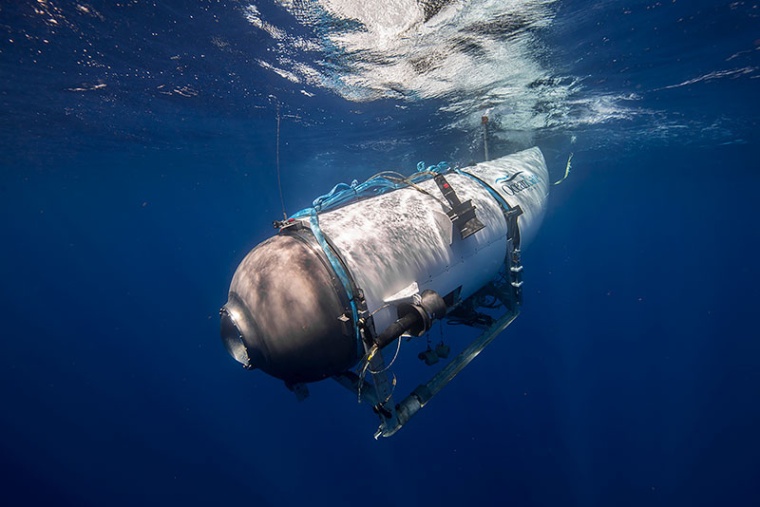
But unlike space, humanity’s presence deep in the world’s oceans is minimal, and the technology for search-and-recovery missions is limited.
The sub’s oxygen supply is the most pressing factor in the search, but it’s hardly the only challenge, said Jamie Pringle, a professor of forensic geosciences at Keele University in the United Kingdom. Scouring such extreme depths is challenging because the seafloor is more rugged than land, he said.
Only a finite amount of oxygen left on missing vessel
The U.S. Coast Guard and those aiding in the search for Titan are in a race against time, with the vessel having a finite oxygen supply.
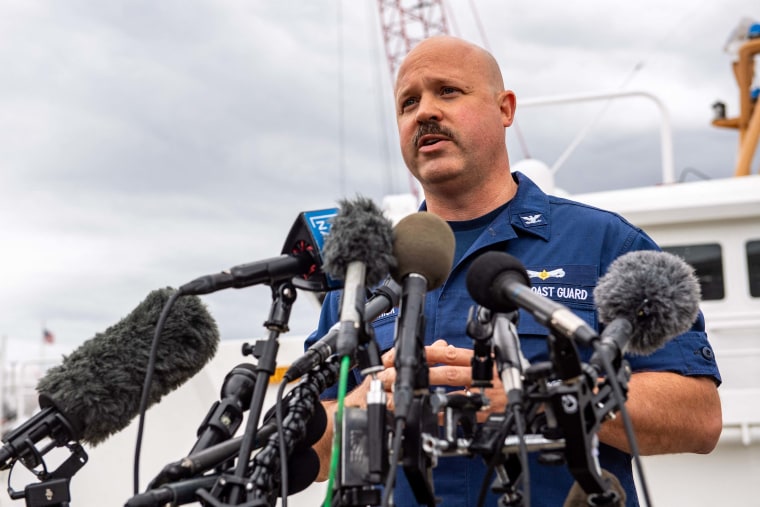
The sub had up to 96 hours of oxygen supply and by 1 p.m. ET Tuesday afternoon, U.S. Coast Guard officials said it had roughly 41 hours left.
Rescuers trying to find the submersible are not only racing against the clock, but they also must contend with difficult search conditions in an unforgiving environment.
Aircraft detect ‘underwater noises’ during search
Canadian aircraft searching for signs of the missing submersible detected “underwater noises” in the search area, the U.S. Coast Guard said early Wednesday.
The underwater noises, detected by Canadian P-3 aircraft, prompted redirected searches by remotely operated vehicles, the Coast Guard tweeted shortly before 12:30 a.m. ET.
“Those ROV searches have yielded negative results but continue,” the Coast Guard said. “Additionally, the data from the P-3 aircraft has been shared with our U.S. Navy experts for further analysis which will be considered in future search plans.” A representative said OceanGate was unable to provide any additional information.













